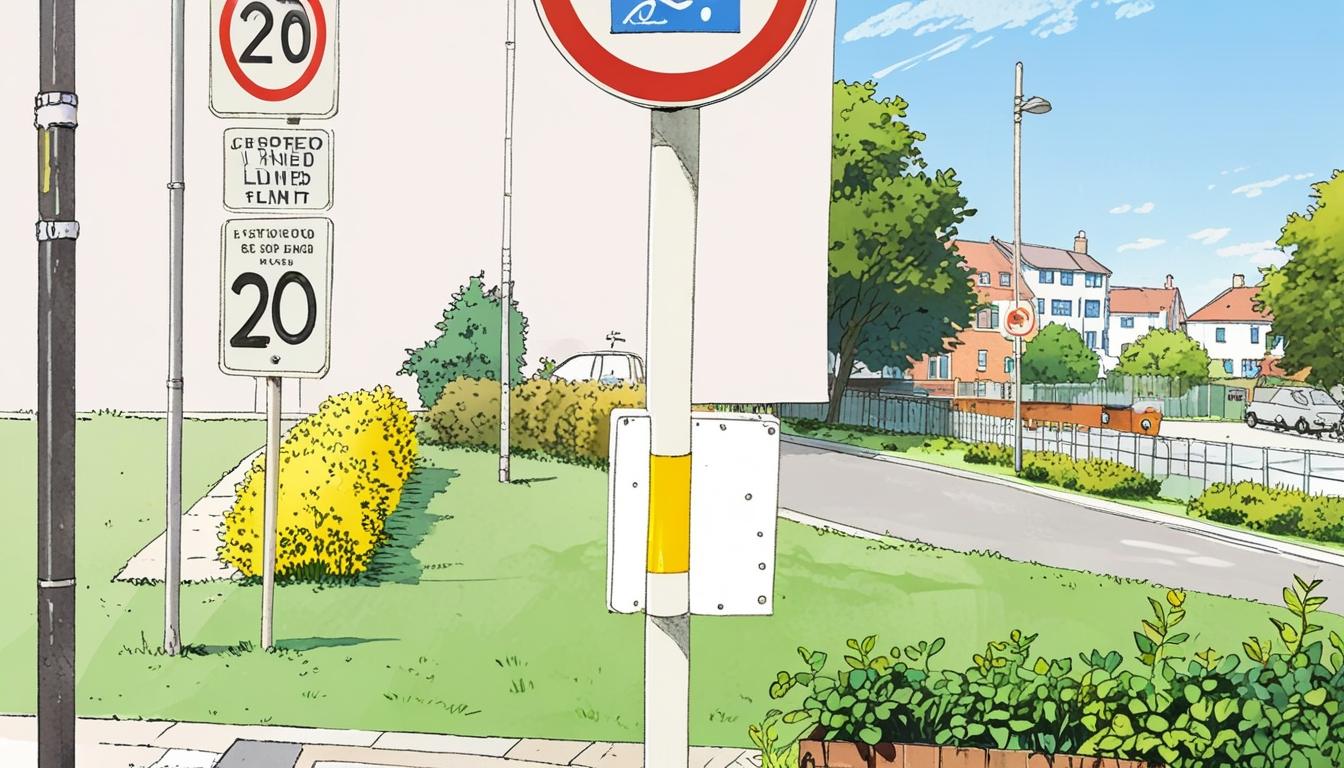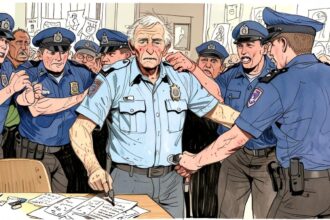Aberdeen City Council aims to slash urban speed limits by expanding 20mph zones from 1,203 to nearly 2,700 roads by 2025, aligning with Scotland’s Road Safety Framework to 2030. Yet concerns grow over enforcement challenges and backlash from drivers frustrated by slowed traffic on major routes.
As I scrutinised a small, laminated notice attached to a lamp post, a common sight in local councils, I couldn’t help but wonder what implications it might hold. In Aberdeen, where rampant roadworks seem to spring up weekly, these notices often pertain to various matters that can directly affect daily life, be it related to housing regulations or traffic conditions. This particular notice, however, was announcing a consultation regarding the introduction of a 20mph speed limit along the road where I stood.
With a children’s play park located midway along this street, the proposed speed reduction appeared sensible, especially given the frequent foot traffic from parents and their young children. The narrowness of the road, frequently congested with parked vehicles, only heightened the risks. But amidst my contemplation, a concerning scene unfolded: a car raced past, tyres screeching as it seemingly hit speeds well over 60mph downhill, careening dangerously close to pedestrians.
Observing this reckless behaviour—the sort akin to a “boy racer” demonstrate—left me pondering the efficacy of the new speed limit. While the council’s intention to implement a 20mph zone here reflects a commitment to road safety, it raises critical questions about enforcement. Who will ensure compliance among those unwilling to adhere to safety regulations?
The urgency for such measures has been underscored by Aberdeen City Council’s broader campaign aligning with the Scottish Government’s ambitious ‘Scotland’s Road Safety Framework to 2030’, which aspires to halve road deaths in the next seven years and achieve zero fatalities by 2050. The initiative seeks to expand 20mph zones across urban areas in the city, aiming to create safer environments for pedestrians, cyclists, and drivers alike.
With the Council’s plan to transform hundreds of streets into 20mph zones, including over 1,474 additional roads on top of the 1,203 already designated, their goal is ambitious yet necessary. Current planning indicates a reduction of roads permitting higher speeds from 1,725 to just 251 in built-up areas by 2025. This initiative not only hopes to improve road safety but also aims to promote active travel and enhance air quality within communities.
However, the acknowledgement of frustration among drivers is causing concern regarding the potential backlash against these restrictions. The A96 and A9 routes to Inverness often draw ire due to inadequate infrastructure and slow traffic flow. Proposals to lower speeds on major arteries, such as plans for 50mph limits on single-carriageway sections, have encountered substantial opposition, with local sentiment largely rejecting such measures.
Highland MSP Fergus Ewing has labelled these proposals as “misguided,” arguing for more context-sensitive approaches that would better consider the needs of motorists. The inconsistency in messaging surrounding speed limits—whether they serve as safety measures or merely cumbersome regulations—has sparked continued debate within the community.
The situation on the roads in Aberdeen illustrates a complex entanglement: the desire for safety against the backdrop of real-world driving behaviours and frustrations. As I witnessed the chaotic ballet of cars and cyclists on that fateful day, it became evident that while a 20mph limit may dramatically enhance safety in critical areas, its efficacy ultimately hinges on robust enforcement and a culture of responsible driving.
In these evolving discussions about speed limits, we are reminded that while regulations are intended to protect, they must also align with practical realities on the ground. As Aberdeen moves forward with its plans to enhance road safety, the hope is that innovative strategies will emerge to not only legislate speed but to foster a genuine respect for it.
Reference Map
- Paragraph 1: (1)
- Paragraph 2: (1)
- Paragraph 3: (1), (2)
- Paragraph 4: (4), (7)
- Paragraph 5: (3), (6)
- Paragraph 6: (5)
- Paragraph 7: (6)
- Paragraph 8: (3), (4)
- Paragraph 9: (2), (5)
- Paragraph 10: (3)
- Paragraph 11: (1)
Source: Noah Wire Services
- https://www.pressandjournal.co.uk/fp/news/aberdeen-aberdeenshire/6753035/david-knight-aberdeen-20mph-zones/ – Please view link – unable to able to access data
- https://www.aberdeencity.gov.uk/news/new-20mph-speed-limit-will-improve-road-safety – Aberdeen City Council has approved the implementation of a 20mph speed limit in the northern part of the city to enhance road safety. This decision aligns with the Scottish Government’s ‘Scotland’s Road Safety Framework to 2030’, aiming to halve road deaths by 2030 and achieve zero fatalities by 2050. The strategy includes expanding 20mph zones across Scotland, with Aberdeen’s initiative being a significant step towards this goal. Council Co-Leader Ian Yuill emphasized that lower speeds will make Aberdeen’s streets safer for all, particularly pedestrians. The implementation is part of a broader effort to improve road safety and encourage active travel in urban areas. ([aberdeencity.gov.uk](https://www.aberdeencity.gov.uk/news/new-20mph-speed-limit-will-improve-road-safety?utm_source=openai))
- https://www.aberdeencity.gov.uk/20mph-speed-limit – Aberdeen City Council is expanding 20mph speed limits across the city to improve safety for pedestrians, cyclists, and drivers. The initiative follows the Scottish Government’s ‘Scotland’s Road Safety Framework to 2030’, which aims to halve road deaths by 2030 and achieve zero fatalities by 2050. The council has identified several residential areas where the 20mph limit will be implemented, with plans to complete the process by December 2025. The strategy is expected to reduce road danger perceptions, promote active travel, and improve air quality. ([aberdeencity.gov.uk](https://www.aberdeencity.gov.uk/20mph-speed-limit?utm_source=openai))
- https://www.aberdeenlive.news/news/aberdeen-news/council-consult-public-20mph-limit-9336849 – Aberdeen City Council is consulting on expanding 20mph speed limits across hundreds of streets to enhance safety in built-up areas. Currently, 1,203 roads have 20mph limits, with an additional 1,474 streets proposed, totaling 2,677. The existing 1,725 roads with 30mph limits would be reduced to 251. The Scottish Government aims to ensure all appropriate roads in built-up areas have a 20mph limit by 2025. The council emphasizes that lower speeds will make Aberdeen’s streets safer for all, particularly pedestrians. ([aberdeenlive.news](https://www.aberdeenlive.news/news/aberdeen-news/council-consult-public-20mph-limit-9336849?utm_source=openai))
- https://www.pressandjournal.co.uk/fp/news/aberdeen-aberdeenshire/6675524/king-street-aberdeen-20mph-zones/ – Aberdeen City Council has approved reducing the speed limit on parts of King Street and other major roads from 30mph to 20mph to enhance safety. The plan affects over 1,400 streets, including parts of Auchmill Road, Ellon Road in Bridge of Don, Great Northern Road, and the Lang Stracht. The council aims to implement the 20mph limit in densely populated areas with high footfall. The Scottish Government’s strategy seeks to expand 20mph zones across Scotland, with Aberdeen’s initiative being a significant step towards this goal. ([pressandjournal.co.uk](https://www.pressandjournal.co.uk/fp/news/aberdeen-aberdeenshire/6675524/king-street-aberdeen-20mph-zones/?utm_source=openai))
- https://www.gbnews.com/lifestyle/cars/driving-laws-aberdeen-20mph-speed-limits-concerns – Aberdeen City Council has approved the widespread implementation of 20mph speed limits on numerous roads to improve road safety. The decision aligns with the Scottish Government’s ‘Scotland’s Road Safety Framework to 2030’, aiming to halve road deaths by 2030 and achieve zero fatalities by 2050. The council emphasizes that lower speeds will make Aberdeen’s streets safer for all, particularly pedestrians. The initiative has sparked discussions about potential driver frustration due to reduced speed limits. ([gbnews.com](https://www.gbnews.com/lifestyle/cars/driving-laws-aberdeen-20mph-speed-limits-concerns?utm_source=openai))
- https://www.agcc.co.uk/news-article/new-20mph-speed-limit-will-improve-road-safety – Aberdeen City Council has agreed to implement a 20mph speed limit in the northern part of the city to improve road safety. This decision aligns with the Scottish Government’s ‘Scotland’s Road Safety Framework to 2030’, aiming to halve road deaths by 2030 and achieve zero fatalities by 2050. The strategy includes expanding 20mph zones across Scotland, with Aberdeen’s initiative being a significant step towards this goal. Council Co-Leader Ian Yuill emphasized that lower speeds will make Aberdeen’s streets safer for all, particularly pedestrians. ([agcc.co.uk](https://www.agcc.co.uk/news-article/new-20mph-speed-limit-will-improve-road-safety?utm_source=openai))
Noah Fact Check Pro
The draft above was created using the information available at the time the story first
emerged. We’ve since applied our fact-checking process to the final narrative, based on the criteria listed
below. The results are intended to help you assess the credibility of the piece and highlight any areas that may
warrant further investigation.
Freshness check
Score:
8
Notes:
The narrative discusses current initiatives and future plans for Aberdeen, aligning with ongoing road safety measures. However, without a specific date or recent event referenced in the text, it’s difficult to gauge absolute freshness.
Quotes check
Score:
5
Notes:
There are no direct quotes provided in the text, making it impossible to verify their original source or date.
Source reliability
Score:
7
Notes:
The narrative originates from ‘Press and Journal’, a local Scottish newspaper, which generally provides reliable regional news. However, the lack of global recognition or broader journalistic acclaim might raise some doubts about its influence or credibility outside local contexts.
Plausability check
Score:
9
Notes:
The claims about Aberdeen’s road safety initiatives and the expansion of 20mph zones are plausible and align with broader policies to enhance road safety in Scotland. The Scottish Government’s ‘Scotland’s Road Safety Framework to 2030’ is a real initiative that supports such measures.
Overall assessment
Verdict (FAIL, OPEN, PASS): PASS
Confidence (LOW, MEDIUM, HIGH): MEDIUM
Summary:
The narrative appears plausible and well-grounded in current road safety policies, but lacks specific dates and direct quotes for enhanced verification. The source is generally reliable for local news.













